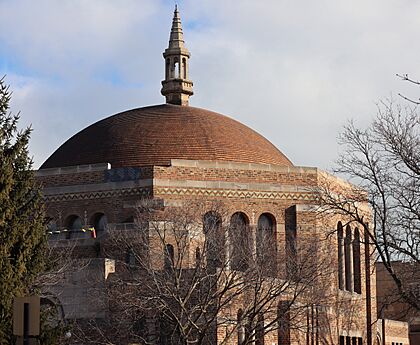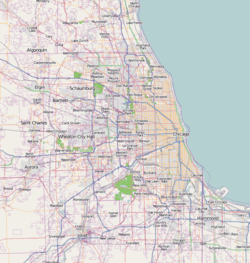KAM Isaiah Israel facts for kids
Quick facts for kids KAM Isaiah Israel |
|
|---|---|
|
Hebrew: קהלת אנשי מערב
|
|

KAM synagogue building, in 2021
|
|
| Religion | |
| Affiliation | Reform Judaism |
| Ecclesiastical or organisational status | Synagogue |
| Leadership | Rabbi Daniel Kirzane Cantor David Berger |
| Status | Active |
| Location | |
| Location | 1100 East Hyde Park Boulevard, Chicago, Illinois |
| Country | United States |
| Architecture | |
| Architect(s) |
|
| Architectural type | Synagogue |
| Architectural style | Byzantine Revival |
| Date established | 1847 (as a congregation) |
| Completed | 1924 |
| Specifications | |
| Direction of façade | West |
| Capacity |
|
| Dome(s) | Three (1 large; 2 small) |
| Spire(s) | One (reminiscent of a minaret) |
| Designated | June 9, 1977 |
KAM Isaiah Israel is a special Jewish place of worship, called a synagogue. It follows the Reform Jewish tradition. You can find it in the historic Kenwood neighborhood of Chicago, Illinois. This synagogue is the oldest Jewish community in Chicago! It started way back in 1847. Back then, it was known as Kehilath Anshe Ma'arav, which means "Congregation of the Men of the West."
Contents
History of KAM Isaiah Israel
The congregation Kehilath Anshe Ma'arav was founded on November 3, 1847. Twenty men, many from Bavaria, started it in a dry-goods store. This store was located at 155 East Lake Street in Chicago. At that time, this area was the center of Chicago's small Jewish community.
Early Buildings and Moves
The new congregation first met above the store. As more people joined, they needed a bigger space. They leased land at Clark and Quincy streets. Construction of a small synagogue began there. This building, which could hold 450 people, was finished on June 13, 1851. It cost about $12,000 to build.
Just two years later, their land lease ended. The congregation had to move the entire building! They moved it to Adams and Wells streets in 1853. This building survived the Great Chicago Fire of 1871. However, it was later destroyed in the Chicago Fire of 1874.
New Locations and Mergers
In 1890, KAM moved into a new temple. This building was designed by famous architects Louis Sullivan and Dankmar Adler. It was located in the Bronzeville area. In 1924, KAM moved again to a private home in Hyde Park. The old synagogue building in Bronzeville became the Pilgrim Baptist Church. This church is famous as the birthplace of Gospel music. It was recognized as a historic place in 1973 and a Chicago Landmark in 1981. Sadly, a fire partly destroyed it in 2006.
In 1971, KAM joined with another Reform Jewish congregation called Isaiah Israel. Together, they became KAM Isaiah Israel. This is the name of the synagogue today.
The Current Synagogue Building
The current synagogue building is in Chicago's Kenwood neighborhood. This area is known for its large homes. Famous people like Barack Obama and Muhammad Ali have lived nearby. The synagogue was built in the Byzantine Revival style. It was designed by Alfred S. Alschuler in 1924. He was inspired by old photographs of a synagogue found in Tiberias, Galilee. Later, his son John Alschuler and Ron Dirsmith designed additions to the building. This beautiful building was named an official Chicago Landmark on June 9, 1977.
Religious Journey and Reform Identity
KAM Isaiah Israel is the oldest Jewish congregation in Illinois. It started many years before any other synagogue in the state.
Early Orthodox Beginnings (1847–1850s)
When the congregation first began, many of its German Jewish founders followed Orthodox traditions. This means they kept very strict Jewish practices. Their first rabbi, Ignatz Kunreuther, served from 1847 to 1853. He was known for sticking closely to old traditions. The congregation's early rules also showed their commitment to Orthodox practices. For example, they made sure to follow kosher dietary laws.
Steps Towards Reform (1852–1860s)
However, ideas for change started early in KAM's history. By 1852, some members wanted reforms in the services. They wanted to stop certain rituals and sing hymns in English. They also wanted to use an organ during singing. These changes were not easy and faced criticism. Some founders wanted to change slowly. But newer members wanted faster changes.
This desire for reform grew stronger in the late 1850s. A leader named Dr. David Einhorn inspired many people in Chicago. This led to some members leaving KAM to form a new Reform congregation called Sinai Congregation in 1861.
The Liebman Adler Era (1861-1883)
The 1860s were a big time for change under Rabbi Liebman Adler. He led the congregation from 1861 to 1883. Rabbi Adler was traditional but also understood the need for modern changes. He helped bridge the gap between the congregation's Orthodox past and its Reform future.
Rabbi Adler believed the Bible could be understood in different ways. He said that some parts were strict commands, but other parts were like stories that needed explanation. He also believed that Jewish people could be fully American citizens. He showed this by being a strong American patriot during the Civil War. He even sent his oldest son to fight for the Union Army. This idea of combining Jewish identity with American citizenship is a key part of Reform Judaism.
Becoming Officially Reform (1874)
In 1874, the congregation officially joined the Union of American Hebrew Congregations. This made KAM formally part of the Reform movement in America. They started using a new prayer book and held Friday evening services with a choir and sermon. These changes were a big shift from their earlier Orthodox practices.
20th Century Influence
KAM Isaiah Israel has been very important in the Reform movement. Four of its rabbis have even been elected president of the Central Conference of American Rabbis. This is the main group for Reform rabbis.
Rabbi Jacob J. Weinstein, who served from 1939 to 1967, was one of these leaders. He was president of the Central Conference from 1965 to 1969. He was a strong supporter of social justice and fought against racism. His leadership helped shape Reform Judaism's focus on social action.
Rabbi Hayim Goren Perelmuter led Temple Isaiah Israel before the merger in 1971. He helped bring the two congregations together. He also became the first Professor of Jewish Studies at Catholic Theological Union. He worked to improve understanding between Jewish and Christian communities.
The 1971 Merger and Continued Evolution
The merger of KAM and Isaiah Israel in 1971 created the KAM Isaiah Israel we know today. This merger made the Reform identity even stronger. It brought together two Reform congregations, combining their strengths and members. This created a more powerful community dedicated to the ideas of Reform Judaism. The merger also brought the congregation to its current beautiful building.
Social Justice and Community Involvement
KAM Isaiah Israel has a long history of working for social justice.
Rabbi Arnold Jacob Wolf's Leadership (1980-2000)
Rabbi Arnold Jacob Wolf was a key leader in social activism for the merged KAM Isaiah Israel. He believed that faith and social action went hand in hand. He marched in Selma, Alabama, for civil rights. He also invited important speakers to the synagogue, like the Rev. Dr. Martin Luther King Jr. and the Chicago Seven. These actions show his strong commitment to social justice. Because of leaders like Rabbi Wolf, KAM Isaiah Israel is known today as a leading social action congregation.
Current Community Engagement
The congregation continues its tradition of social justice today. They have programs like the Rabbinic Heritage Committee, started in 2017. This committee honors past social activist rabbis. It sponsors programs that promote Jewish thought, social justice, and understanding between different faiths.
KAM Isaiah Israel also works with other social justice groups in Chicago. They are a founding member of the Jewish Council on Urban Affairs synagogue partnership. This group speaks up for social justice in Chicago. The congregation is also involved in the Hyde Park Refugee Project. This project helps immigrants and shows their commitment to human rights.
Notable Members
- Dankmar Adler, a German-born architect and engineer
- Leon Despres, an author, lawyer, and Chicago Alderman
- Solomon Freehof, a rabbi who served from 1924–1934
- Arthur Goldberg, a politician who was the 9th U.S. Secretary of Labor and a Supreme Court Justice
- Max Janowski, a German-born composer of Jewish religious music
- Donald N. Levine, a sociologist and professor at the University of Chicago
- Abner Mikva, a politician who was a U.S. Representative and a federal judge
- Martha Nussbaum, a philosopher and professor at the University of Chicago
- Sara Paretsky, an author who writes detective stories
- Arnold Jacob Wolf, a rabbi who served from 1980–2000
See also
- History of the Jews in Chicago
- List of Chicago Landmarks
- Pilgrim Baptist Church
- A sample of synagogues built in the Neo-Byzantine style:
- Hurva Synagogue, Jerusalem, Israel
- Grand Choral Synagogue, Saint Petersburg, Russia
- Congregation Beth Israel, West Hartford, Connecticut


